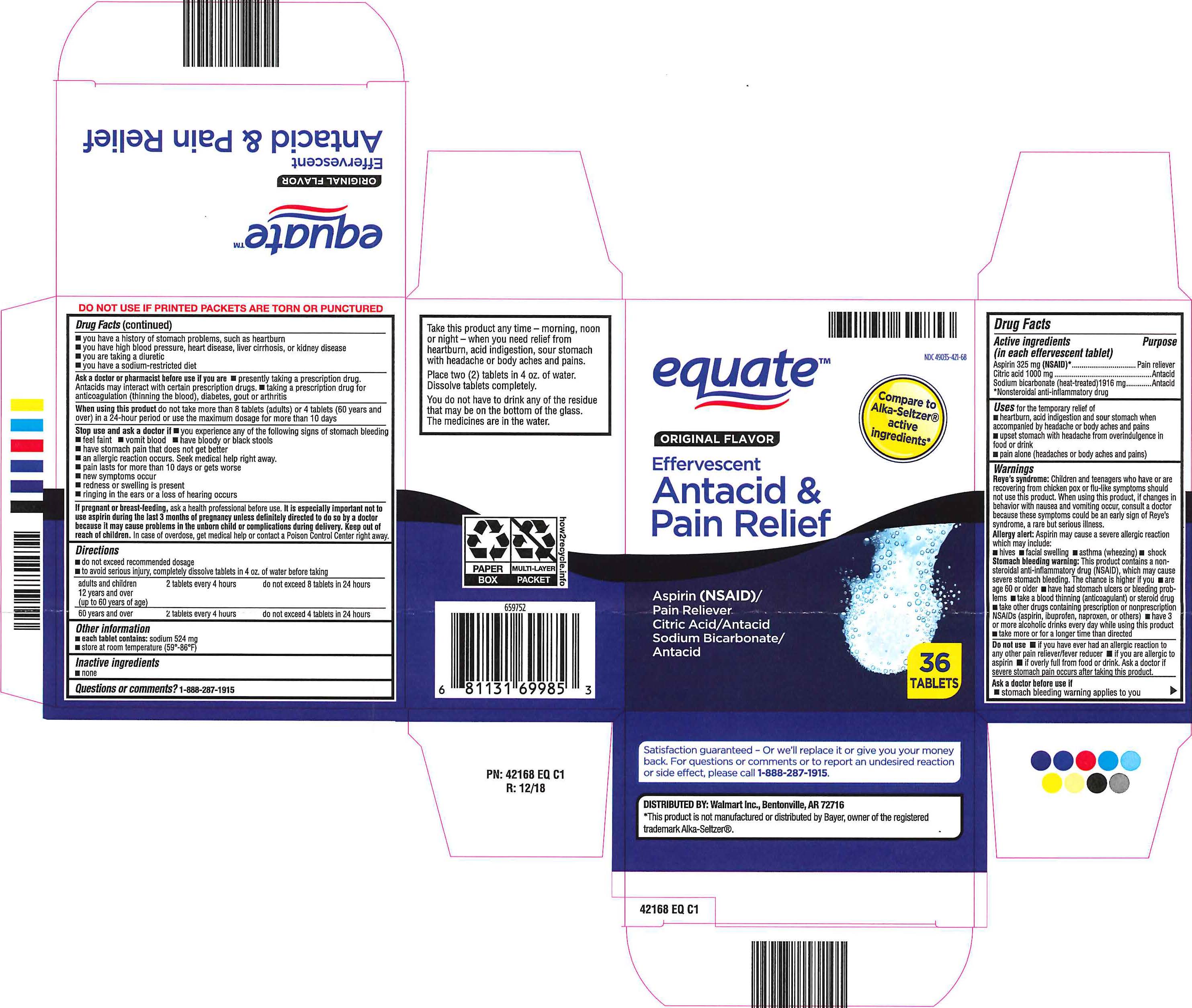Equate Effervescent Antacid And Pain Relief while Breastfeeding

What is Equate Effervescent Antacid And Pain Relief used for?
Purpose: Aspirin 325 mg (NSAID)*. . . . . . . . . . . . . . . . . . . . . .Pain reliever Citric acid 1000 mg . . . . . . . . . . . . . . . . . . . . . .. . . . Antacid Sodium bicarbonate (heat-treated) 1916 mg . . . . . . Antacid *Nonsteroidal anti-inflammatory drug
I am currently breastfeeding and I want to know if using Equate Effervescent Antacid And Pain Relief is safe for my kid? Does it have any effect on milk production?

Equate Effervescent Antacid And Pain Relief Breastfeeding Analsys
Aspirin while Breastfeeding
Low RiskCAS Number: 50-78-2
Excreted in non-significant amount into breast milk. Reye’s Syndrome has never been reported due to ASA through breast milk. It is thought to be highly unlikely to occur after isolated or small doses like those used for treatment of thrombosis or anti-abortion therapy. At high maternal dose, one case (dubious) of salicylic intoxication in the neonatal period and another case of thrombocytopenia in an infant have been reported. Likelihood of hemolysis should be considered in those patients with G6PD-deficiency. WHO Model List of Essential Medication: compatible while breastfeeding when used occasionally or small dose for antithrombotic prophylaxis management.
Sodium bicarbonate while Breastfeeding
SafeCAS Number: 144-55-8
It is contained in preparations used for treatment of excessive gastric acidity, oral rehydration solutions and fluids for intravenous use that aim the correction of acute metabolic acidosis. Also used for long-standing treatment of chronic metabolic acidosis due to kidney malfunction. Oral bicarbonate solutions neutralize gastric acidity with production of Carbon Dioxide. The rest is absorbed by the gut. In the plasma, bicarbonate is kept at normal physiological range, with the excess eliminated by the kidney. Epithelial cells of the mammary gland regulate the entrance of sodium and bicarbonate into the mother's milk, with little effect on milk composition due to diet. Bicarbonate decreases secretion of Prolactin in cases of secondary Hyperprolactinemia due to metabolic acidosis, but does not affect production of the milk. WHO Model List of Essential Medicines (2002): compatible with breastfeeding
Anhydrous citric acid while Breastfeeding
SafeCAS Number: 77-92-9
Product that is naturally found in most fruits, especially citrus ones, and which is industrially produced through fermentation of sugar by the fungus Aspergillus niger. It is used in medical compounds as effervescent, to treat intestinal affections, as antioxidant, as an agent for alkalizing urine and dissolution of urinary tract stones. In the food industry it is used as additive (E 330) due to its antioxidant, preservative and flavoring properties. Devoid of toxicity when used at appropriate doses.
Equate Effervescent Antacid And Pain Relief Breastfeeding Analsys - 2
Aspirin while Breastfeeding
CAS Number: 50-78-2
After aspirin ingestion, salicylic acid is excreted into breastmilk, with higher doses resulting in disproportionately higher milk levels. Long-term, high-dose maternal aspirin ingestion probably caused metabolic acidosis in one breastfed infant. Reye's syndrome is associated with aspirin administration to infants with viral infections, but the risk of Reye's syndrome from salicylate in breastmilk is unknown. An alternate drug is preferred over continuous high-dose, aspirin therapy. After daily low-dose aspiring (75 to 325 mg daily), no aspirin is excreted into breastmilk and salicylate levels are low. Daily low-dose aspirin therapy may be considered as an antiplatelet drug for use in breastfeeding women.[1][2][3].
What should I do if already breastfed my kid after using Equate Effervescent Antacid And Pain Relief?
Equate Effervescent Antacid And Pain Relief is in the category of low risk, if you have already used it then its not a big deal if health and behavior of baby is good. However your health care provider shall be aware of the fact that you have used Equate Effervescent Antacid And Pain Relief so you should inform him based on your convenience.
My health care provider has asked me to use Equate Effervescent Antacid And Pain Relief, what to do?
Equate Effervescent Antacid And Pain Relief comes in category of low risk and if your doctor is aware that you are breastfeeding it should be ok to use
If I am using Equate Effervescent Antacid And Pain Relief, will my baby need extra monitoring?
Not much monitoring required while using Equate Effervescent Antacid And Pain Relief
Who can I talk to if I have questions about usage of Equate Effervescent Antacid And Pain Relief in breastfeeding?
US
National Womens Health and Breastfeeding Helpline: 800-994-9662 (TDD 888-220-5446) 9 a.m. and 6 p.m. ET, Monday through Friday
UK
National Breastfeeding Helpline: 0300-100-0212 9.30am to 9.30pm, daily
Association of Breastfeeding Mothers: 0300-330-5453
La Leche League: 0345-120-2918
The Breastfeeding Network supporter line in Bengali and Sylheti: 0300-456-2421
National Childbirth Trust (NCT): 0300-330-0700
Australia
National Breastfeeding Helpline: 1800-686-268 24 hours a day, 7 days a week
Canada
Telehealth Ontario for breastfeeding: 1-866-797-0000 24 hours a day, 7 days a week
